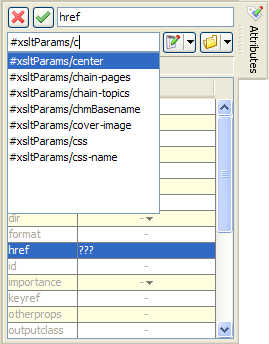4. The <xref> and <link>
elements
The
<xref> “inline element” may be contained in
any “block element”.The  element.
element.
<link> element may be contained only in a
<related-links> Both elements may contain text, though in the case of the
 child
element.
child
element.
<link> element, this text must be wrapped in a
<linktext> For both elements, the target of the link is specified by the value of
the
@href attribute, which is an absolute or relative URL,
possibly ending with a fragment.Examples:
1 2 3 4 5 6 7 8 9 10 11 12 13 |
<xref href="topic_structure.dita"/> <xref href="http://www.xmlmind.com/xmleditor/" format="html" scope="external">XMLmind XML Editor</xref> <link href="samples/sample_topic.dita#docbook_or_dita"/> <link href="http://www.xmlmind.com/ditac/" format="html" scope="external"> <linktext>XMLmind DITA Converter</linktext> </link> |
External links
The target of an external link is
any location outside the overall DITA document. This location may be an
absolute or relative URL. This location is not intended to be transformed
by the DITA processing software (e.g. DITA Open
Toolkit  or XMLmind DITA Converter
or XMLmind DITA Converter  ).
).
Remember
|
Internal links
The target of an internal link
(
<xref> or <link> element)
is a DITA element belonging to the same DITA document. This target element
may be found in the same XML file as the link element or, on the contrary,
in a different XML file. The latter case is still considered to be an
internal link because both the link and its target belong to the same
overall DITA document.Of course, in order to use a DITA element as
the target of a link, this element must have an
@id
attribute.The value of the
@href attribute of a
link element is:
"URL_of_the_target_DITA_file#qualified_ID_of_the_target_element",
where:- URL_of_the_target_DITA_file may be omitted when both the link and its target are found in the same XML file.
- #qualified_ID_of_the_target_element may be omitted if you want to address the first topic contained in an XML file.
What is the qualified ID of the target
element?
- It's simply the value of the
@idattribute for a topic element (of any kind:<topic>,<concept>,<reference>, etc). - It's the value of the
@idattribute of the target element prefixed by "ID_of_the_topic_ancestor/" for any descendant element of a topic.
Example: Let's suppose you want to add an
<xref> element to
topic1.dita:
1 2 3 4 5 6 7 |
<topic id="t1"> <title>Title of topic 1</title> <body> <p id="p1">Paragraph inside topic 1.</p> <p>More information in <xref href="???"/>.</p> </body> </topic> |
Let's suppose that you want to address elements
contained in
topic2.dita, this file being found in
the same directory as topic1.dita.
1 2 3 4 5 6 |
<topic id="t2"> <title>Title of topic 2</title> <body> <p id="p2">Paragraph inside topic 2.</p> </body> </topic> |
- If you want to address topic "t1", specify href="#t1".
- If you want to address paragraph "p1", specify href="#t1/p1".
- If you want to address topic "t2", specify href="topic2.dita#t2" or more simply href="topic2.dita".
- If you want to address paragraph "p2", specify href="topic2.dita#t2/p2".
Remember
|
